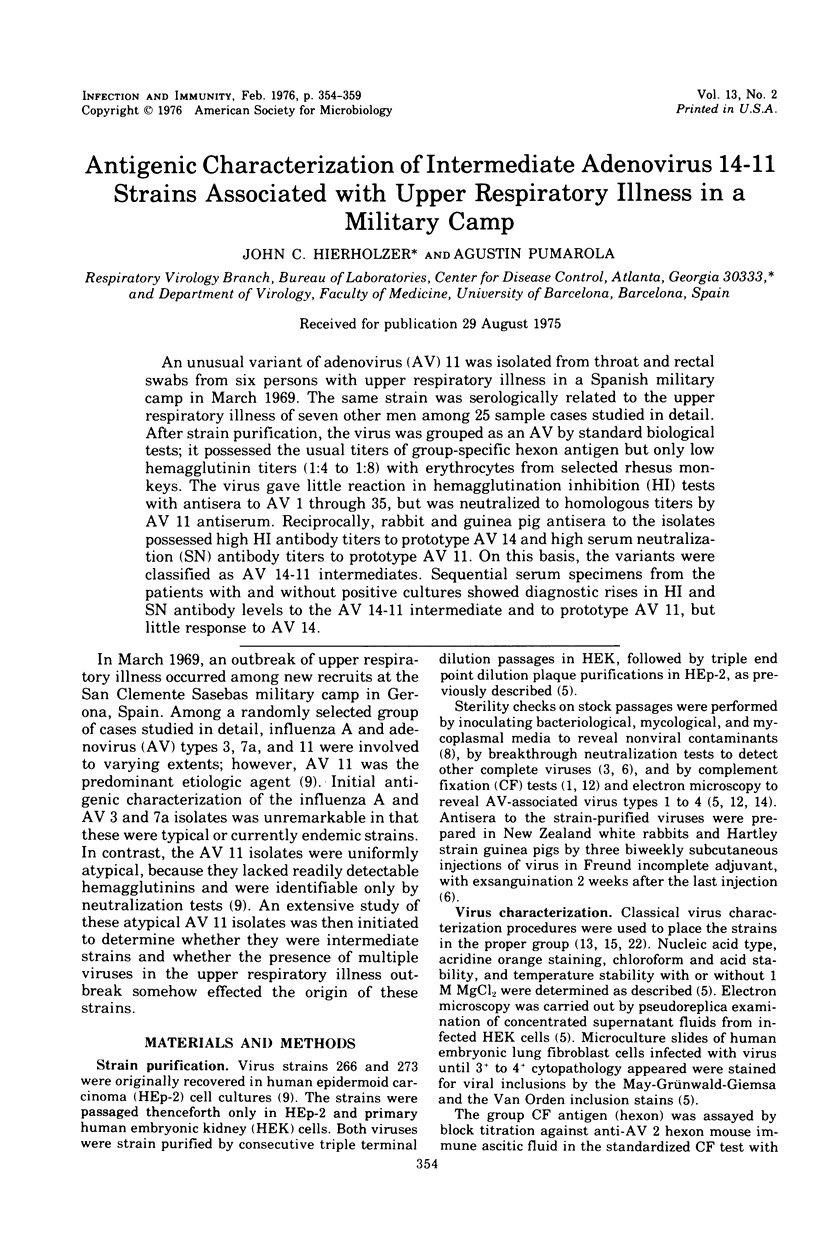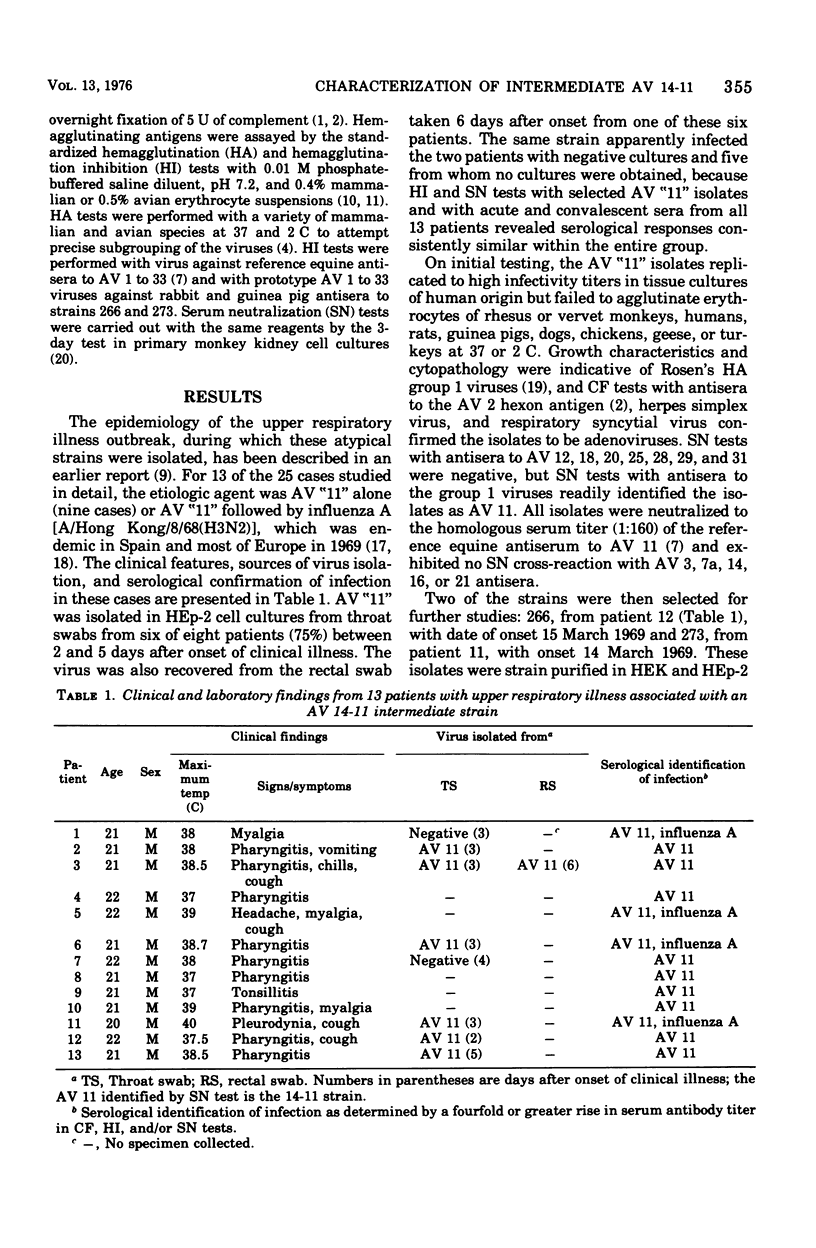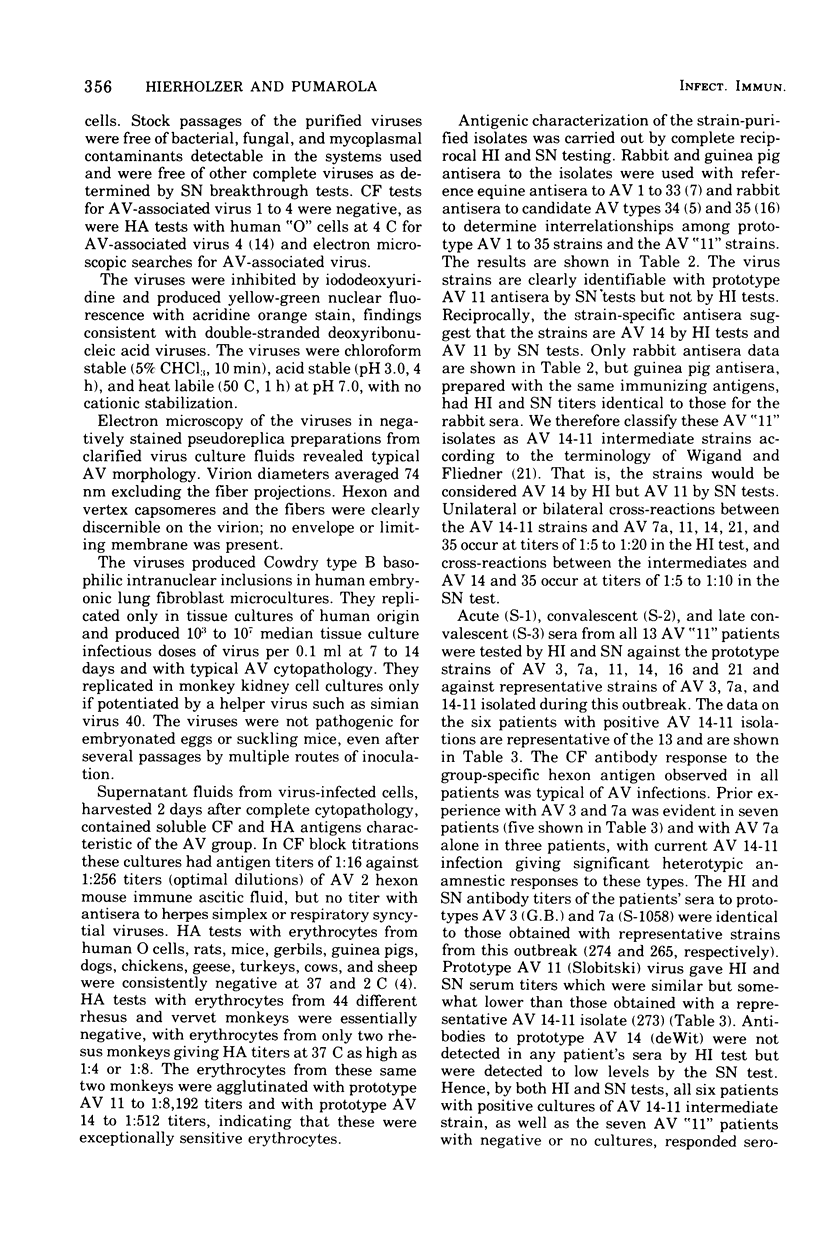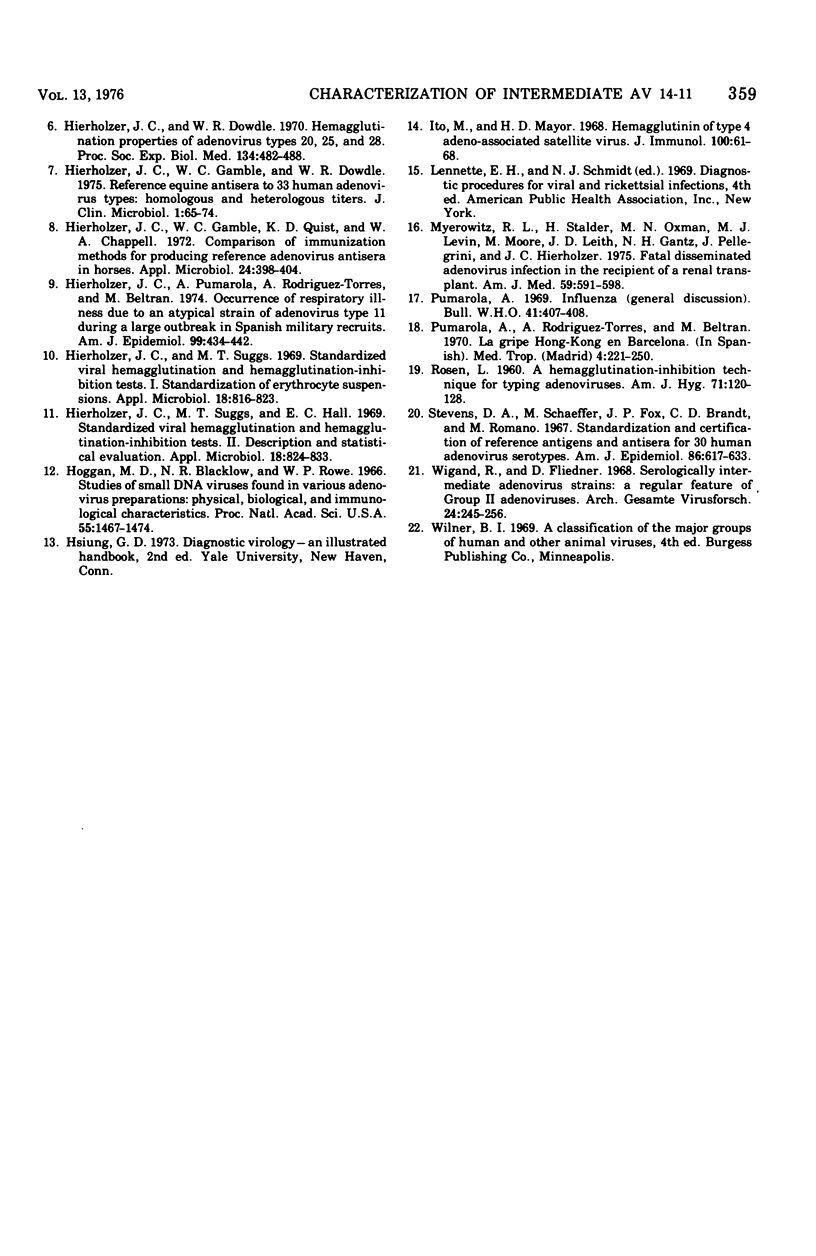Abstract
An unusual variant of adenovirus (AV) 11 was isolated from throat and rectal swabs from six persons with upper respiratory illness in a Spanish military camp in March 1969. The same strain was serologically related to the upper respiratory illness of seven other men among 25 sample cases studied in detail. After strain purification, the virus was grouped as an AV by standard biological tests; it possessed the usual titers of group-specific hexon antigen but only low hemagglutinin titers (1:4 to 1:8) with erythrocytes from selected rhesus monkeys. The virus gave little reaction in hemagglutination inhibition (HI) tests with antisera to AV 1 through 35, but was neutralized to homologous titers by AV 11 antiserum. Reciprocally, rabbit and guinea pig antisera to the isolates possessed high HI antibody titers to prototype AV 14 and high serum neutralization (SN) antibody titers to prototype AV 11. On this basis, the variants were classified as AV 14-11 intermediates. Sequential serum specimens from the patients with and without positive cultures showed diagnostic rises in HI and SN antibody levels to the AV 14-11 intermediate and to prototype AV 11, but little response to AV 14.
Full text
PDF





Selected References
These references are in PubMed. This may not be the complete list of references from this article.
- Dowdle W. R., Lambriex M., Hierholzer J. C. Production and evaluation of a purified adenovirus group-specific (hexon) antigen for use in the diagnostic complement fixation test. Appl Microbiol. 1971 Apr;21(4):718–722. doi: 10.1128/am.21.4.718-722.1971. [DOI] [PMC free article] [PubMed] [Google Scholar]
- Hampil B., Melnick J. L. Method for testing virus stocks for viral contaminants. Appl Microbiol. 1969 Jan;17(1):17–20. doi: 10.1128/am.17.1.17-20.1969. [DOI] [PMC free article] [PubMed] [Google Scholar]
- Hierholzer J. C., Atuk N. O., Gwaltney J. M., Jr New human adenovirus isolated from a renal transplant recipient: description and characterization of candiate adenovirus type 34. J Clin Microbiol. 1975 Apr;1(4):366–376. doi: 10.1128/jcm.1.4.366-376.1975. [DOI] [PMC free article] [PubMed] [Google Scholar]
- Hierholzer J. C., Dowdle W. R. Hemagglutination properties of adenovirus types 20, 25, and 28. Proc Soc Exp Biol Med. 1970 Jun;134(2):482–488. doi: 10.3181/00379727-134-34817. [DOI] [PubMed] [Google Scholar]
- Hierholzer J. C. Further subgrouping of the human adenoviruses by differential hemagglutination. J Infect Dis. 1973 Oct;128(4):541–550. doi: 10.1093/infdis/128.4.541. [DOI] [PubMed] [Google Scholar]
- Hierholzer J. C., Gamble W. C., Dowdle W. R. Reference equine antisera to 33 human adenovirus types: homologous and heterologous titers. J Clin Microbiol. 1975 Jan;1(1):65–74. doi: 10.1128/jcm.1.1.65-74.1975. [DOI] [PMC free article] [PubMed] [Google Scholar]
- Hierholzer J. C., Gamble W. C., Quist K. D., Chappell W. A. Comparison of immunization methods for producing reference adenovirus antisera in horses. Appl Microbiol. 1972 Sep;24(3):398–404. doi: 10.1128/am.24.3.398-404.1972. [DOI] [PMC free article] [PubMed] [Google Scholar]
- Hierholzer J. C., Pumarola A., Rodriguez-Torres A., Beltran M. Occurrence of respiratory illness due to an atypical strain of adenovirus type 11 during a large outbreak in Spanish military recruits. Am J Epidemiol. 1974 Jun;99(6):434–442. doi: 10.1093/oxfordjournals.aje.a121632. [DOI] [PubMed] [Google Scholar]
- Hierholzer J. C., Suggs M. T., Hall E. C. Standardized viral hemagglutination and hemagglutination-inhibition tests. II. Description and statistical evaluation. Appl Microbiol. 1969 Nov;18(5):824–833. doi: 10.1128/am.18.5.824-833.1969. [DOI] [PMC free article] [PubMed] [Google Scholar]
- Hierholzer J. C., Suggs M. T. Standardized viral hemagglutination and hemagglutination-inhibition tests. I. Standardization of erythrocyte suspensions. Appl Microbiol. 1969 Nov;18(5):816–823. doi: 10.1128/am.18.5.816-823.1969. [DOI] [PMC free article] [PubMed] [Google Scholar]
- Hoggan M. D., Blacklow N. R., Rowe W. P. Studies of small DNA viruses found in various adenovirus preparations: physical, biological, and immunological characteristics. Proc Natl Acad Sci U S A. 1966 Jun;55(6):1467–1474. doi: 10.1073/pnas.55.6.1467. [DOI] [PMC free article] [PubMed] [Google Scholar]
- Ito M., Mayor H. D. Hemagglutinin of type 4 adeno-associated satellite virus. J Immunol. 1968 Jan;100(1):61–68. [PubMed] [Google Scholar]
- Myerowitz R. L., Stalder H., Oxman M. N., Levin M. J., Moore M., Leith J. D., Gantz N. M., Hierholzer J. C., Hierholzer J. C. Fatal disseminated adenovirus infection in a renal transplant recipient. Am J Med. 1975 Oct;59(4):591–598. doi: 10.1016/0002-9343(75)90267-3. [DOI] [PubMed] [Google Scholar]
- Pumarola A., Rodríguez-Torres A., Beltrán M. La gripe Hong-Kong en Barcelona. Med Trop (Madr) 1970 Jan-Dec;46(1):221–250. [PubMed] [Google Scholar]
- ROSEN L. A hemagglutination-inhibition technique for typing adenoviruses. Am J Hyg. 1960 Jan;71:120–128. doi: 10.1093/oxfordjournals.aje.a120085. [DOI] [PubMed] [Google Scholar]
- Stevens D. A., Schaeffer M., Fox J. P., Brandt C. D., Romano M. Standardization and certification of reference antigens and antisera for 30 human adenovirus serotypes. Am J Epidemiol. 1967 Nov;86(3):617–633. doi: 10.1093/oxfordjournals.aje.a120771. [DOI] [PubMed] [Google Scholar]
- Wigand R., Fliedner D. Serologically intermediate adenovirus strains: a regular feature of group II adenoviruses. Arch Gesamte Virusforsch. 1968;24(3):245–256. doi: 10.1007/BF01241296. [DOI] [PubMed] [Google Scholar]


